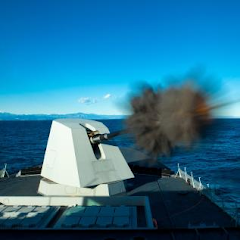On June 28th of this year it was announced that construction had officially begun on Canada’s fleet of Canadian Surface Combatants.
Given that the design and design team contract was originally awarded in February of 2019, the announcement focused largely on federal government messaging about the naming of the class, in the future the CSC will be known as the River-class.
While the Miriam-Webster dictionary defines a destroyer as “a small fast
warship used especially to support larger vessels and usually armed with guns,
depth charges, torpedoes, and often guided missiles” the Canadian
government, in their press release, have defined destroyers as “a powerful and
multi-functional ship, that is a fast, maneuverable, anti-aircraft and
anti-submarine long-endurance warship, which can escort larger vessels in a
fleet, convoy, or carrier battle group and defend them against a wide range of
general threats.”
This is a definition which more accurately describes the 8,800 ton
displacement, missile armed ship previously know as the Canadian Surface
Combatant.
As the Royal Canadian Navy’s next generation combat ship the CSC,
or River class destroyers, will replace both the Iroquois class destroyers and
the Halifax-class frigates.
While the Iroquois class ships have long been retired, the Halifax
class ships, the first of which was launched in 1988, are still in
service. HMCS Ottawa, the most
recently built unit of the 12 ship class, was launched in May of 1996. In the
year 2050, the currently projected in service date for the last
of the River class destroyers, she will be 54 years old.
When in service there were 4 Iroquois class destroyers, with a
displacement of 5,100 long tons each, along with the currently serving 12
Halifax class frigates which displace 4,690 long tons each. The total tonnage
of all 16 vessels being replace is 76,680 long tons.
Compare this to the River class destroyers which, at a displacement of over 8,000 long tons each, come to a total of 121,200 long tons for the fifteen ships currently envisioned.
As a note of interest, the
14 original River class destroyers of WW II fame
displaced approximately 1,340 long tons each for a total of 18,760 long tons.
The graphic provided with the announcement indicates that the government in continuing with the choice of the Leonardo 127mm gun rather then the BAE MK 45 as used by our allies. Explanations of this choice have been less then coherent.
It has been noted that there appears to have been a reduction in weapons on the CSC. Originally the RCN appeared to suggest that there would be 32 Missile Vertical Launch Systems on each combatant. Now, that has been reduced to 24. No explanation was provided.
With only 24 VLS systems the River Class will be seriously under-armed by modern AAW destroyer standards, and will likely be one of the expensive in terms of missile cells/launchers by platform cost and size.
It
has been reported that
government officials acknowledged they don’t have a final cost for the project. It is an indictment of the entire procurement process that is producing these ships that even though ship design started in February 2019 and the preliminary design
review was completed in December 2022 they also still don’t have a final
design.
https://www.canada.ca/en/department-national-defence/news/2024/06/construction-begins-for-canadas-new-warship-fleet--the-river-class-destroyers.html
https://www.tpsgc-pwgsc.gc.ca/app-acq/amd-dp/mer-sea/sncn-nss/navcom-surfcom-eng.html#a2
https://en.wikipedia.org/wiki/HMCS_Ottawa_(FFH_341)
https://www.naval-technology.com/news/canadas-new-river-class-destroyers-begin-construction/
https://www.canada.ca/en/navy/corporate/fleet-units/surface/river-class-destroyer/fact-sheet.html
https://en.wikipedia.org/wiki/Canadian_River-class_destroyer
https://jgmjgm516.blogspot.com/2023/10/why-is-canada-procuring-5-inch-naval.html
https://jgmjgm516.blogspot.com/2023/12/does-anyone-really-know-what-is-going.html
https://en.wikipedia.org/wiki/CAMM_(missile_family)#Operators
https://en.wikipedia.org/wiki/RIM-116_Rolling_Airframe_Missile#Service
https://en.wikipedia.org/wiki/Aegis_Combat_System#Operators
https://www.espritdecorps.ca/feature/introducing-the-river-class-destroyer-the-rcns-new-warship




























